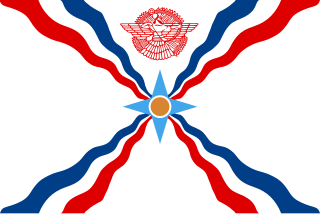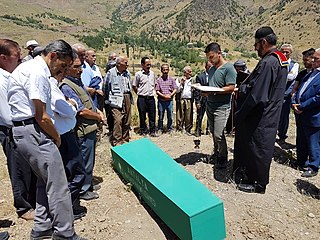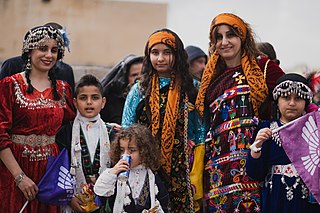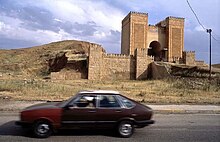
Assyrians are an indigenous ethnic group native to Mesopotamia, a geographical region in West Asia. Modern Assyrians descend from Ancient Mesopotamians such as ancient Assyrians and Babylonians, originating from the ancient indigenous Mesopotamians of Akkad and Sumer, who first developed the civilisation in northern Mesopotamia that would become Assyria in 2600 BCE. Modern Assyrians may culturally self-identify as Syriacs, Chaldeans, or Arameans for religious, geographic, and tribal identification.
The Arameans, or Aramaeans, were an ancient Semitic-speaking people in the Near East that was first recorded in historical sources from the late 12th century BC. The Aramean homeland, sometimes known as the land of Aram, encompassed central regions of modern Syria.

The Sayfo, also known as the Seyfo or the Assyrian genocide, was the mass slaughter and deportation of Assyrian/Syriac Christians in southeastern Anatolia and Persia's Azerbaijan province by Ottoman forces and some Kurdish tribes during World War I.

The Assyrian diaspora refers to ethnic Assyrians living in communities outside their ancestral homeland. The Eastern Aramaic-speaking Assyrians claim descent from the ancient Assyrians and are one of the few ancient Semitic ethnicities in the Near East who resisted Arabization, Turkification, Persianization and Islamization during and after the Muslim conquest of Iraq, Iran, Syria and Turkey.

Iraqi Assyrians are an ethnic and linguistic minority group, indigenous to Upper Mesopotamia. Assyrians in Iraq are those Assyrians still residing in the country of Iraq, and those in the Assyrian diaspora who are of Iraqi-Assyrian heritage. They share a common history and ethnic identity, rooted in shared linguistic, cultural and religious traditions, with Assyrians in Iran, Assyrians in Turkey and Assyrians in Syria, as well as with the Assyrian diaspora. Assyrian diaspora in Detroit, Areas with large expat populations include Chicago and Sydney.

Assyrians in Syria also incorrectly known as Syriacs are an ethnic and linguistic minority that are indigenous to Upper Mesopotamia, the north-eastern half of Syria. Syrian-Assyrians are people of Assyrian descent living in Syria, and those in the Assyrian diaspora who are of Syrian-Assyrian heritage.

Assyrians in Turkey or Turkish Assyrians are an indigenous Semitic-speaking ethnic group and minority of Turkey who are Eastern Aramaic–speaking Christians, with most being members of the Syriac Orthodox Church, Chaldean Catholic Church, Assyrian Pentecostal Church, Assyrian Evangelical Church, or Ancient Church of the East.
The Neo-Aramaic or Modern Aramaic languages are varieties of Aramaic that evolved during the late medieval and early modern periods, and continue to the present day as vernacular (spoken) languages of modern Aramaic-speaking communities. Within the field of Aramaic studies, classification of Neo-Aramaic languages has been a subject of particular interest among scholars, who proposed several divisions, into two, three or four primary groups.

The Assyrian homeland, Assyria, refers to the homeland of the Assyrian people within which Assyrian civilisation developed, located in their indigenous Upper Mesopotamia. The territory that forms the Assyrian homeland is, similarly to the rest of Mesopotamia, currently divided between present-day Iraq, Turkey, Iran and Syria. In Iran, the Urmia Plain forms a thin margin of the ancestral Assyrian homeland in the north-west, and the only section of the Assyrian homeland beyond the Mesopotamian region. The majority of Assyrians in Iran currently reside in the capital city, Tehran.
The Assyrians in the Netherlands are Dutch citizens of Assyrian descent and in the Netherlands mostly known as Arameeërs (Arameans/Syriacs) due to their membership to the Syriac Orthodox Church. They mainly live in the east of the country, in the province of Overijssel, in such cities as Enschede, Hengelo, Rijssen, Almelo and Borne. The main reason that the Assyrians are concentrated there is because it is an industrial area which lies at the Germany–Netherlands border, where a large German Assyrian population resides. Many Assyrians in the Netherlands have relatives in Germany.

The Christians of Iraq are considered to be one of the oldest continuous Christian communities in the world.

Chaldean Catholics, also known as Chaldeans, Chaldo-Assyrians or Assyro-Chaldeans, are ethnic Assyrian adherents of the Chaldean Catholic Church, which originates from the historic Church of the East.

Terms for Syriac Christians are endonymic (native) and exonymic (foreign) terms, that are used as designations for Syriac Christians, as adherents of Syriac Christianity. In its widest scope, Syriac Christianity encompass all Christian denominations that follow East Syriac Rite or West Syriac Rite, and thus use Classical Syriac as their main liturgical language. Traditional divisions among Syriac Christians along denominational lines are reflected in the use of various theological and ecclesiological designations, both historical and modern. Specific terms such as: Jacobites, Saint Thomas Syrian Christians, Maronites, Melkites, Nasranis, and Nestorians have been used in reference to distinctive groups and branches of Eastern Christianity, including those of Syriac liturgical and linguistic traditions. Some of those terms are polysemic, and their uses have been a subject of terminological disputes between different communities, and also among scholars.

Assyrian nationalism is a movement of the Assyrian people that advocates for independence or autonomy within the regions they inhabit in northern Iraq, northeastern Syria, northwestern Iran, and southeastern Turkey.
The Hidden Pearl: The Syrian Orthodox Church And Its Ancient Aramaic Heritage is a 2001 documentary directed by Marcello Baldi. It was commissioned by the Syriac Orthodox Church and co-produced by Trans World Film Italia and Syriac Universal Alliance. The documentary was released as a three-episode miniseries together with three printed volumes.

Christianity, which originated in the Middle East during the 1st century AD, is a significant minority religion within the region, characterized by the diversity of its beliefs and traditions, compared to Christianity in other parts of the Old World. Christians now make up approximately 5% of the Middle Eastern population, down from 20% in the early 20th century. Cyprus is the only Christian majority country in the Middle East, with Christians forming between 76% and 78% of the country's total population, most of them adhering to Eastern Orthodox Christianity. Lebanon has the second highest proportion of Christians in the Middle East, around 40%, predominantly Maronites. Egypt has the next largest proportion of Christians, at around 10% of its total population. Copts, numbering around 10 million, constitute the single largest Christian community in the Middle East.
The Eastern Aramaic languages have developed from the varieties of Aramaic that developed in and around Mesopotamia, as opposed to western varieties of the Levant. Most speakers are ethnic Syriac, although there are a minority of History of the Jews and Mandaeans, who also speak varieties of Eastern Aramaic.
Syriac studies is the study of the Syriac language and Syriac Christianity. A specialist in Syriac studies is known as a Syriacist. Specifically, British, French, and German scholars of the 18th and 19th centuries who were involved in the study of Syriac/Aramaic language and literature were commonly known by this designation, at a time when the Syriac language was little understood outside Assyrian, Syriac Christian and Maronite Christian communities. In Germany the field of study is distinguished between Aramaistik and Neuaramaistik.

Assyrian continuity is the study of continuity between the modern Assyrian people, a Semitic indigenous ethnic, religious and linguistic minority in the Middle East, and the people of ancient Assyria and Mesopotamia generally. Assyrian continuity is a key part of the identity of the modern Assyrian people. No archaeological, genetic, linguistic or written historical evidence exists of the original Assyrian and Mesopotamian population being exterminated, removed, bred out or replaced in the aftermath of the fall of the Assyrian Empire, modern contemporary scholarship "almost unilaterally" supports Assyrian continuity, recognizing the modern Assyrians as the ethnic, linguistic and genetic descendants of the East Assyrian-speaking population of Bronze Age and Iron Age Assyria, and Mesopotamia in general, which were composed of both the old native Assyrian population and of neighbouring settlers in the Assyrian heartland.

The Catholic Church in the Middle East is under the spiritual leadership of the Pope in Rome. The Catholic Church is said to have traditionally originated in the Middle East in the 1st century AD, and was one of the major religions of the region from the 4th-century Byzantine reforms until the centuries following the Arab Islamic conquests of the 7th century AD. Ever since, its proportion has decreased until today's diaspora tendency, mainly due to persecution by Islamic majority societies. In most Islamic countries, the Catholic Church is severely restricted or outlawed. Significant exceptions include Israel and Lebanon.












